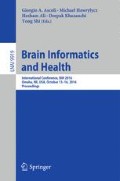Abstract
Assuming that the topological space containing all possible brain states forms a very high-dimensional manifold, this paper proposes an unsupervised manifold learning framework to reconstruct and visualize this manifold using EEG brain connectivity data acquired from a group of healthy volunteers.
Once this manifold is constructed, the temporal sequence of an individual’s EEG activities can then be represented as a trajectory or thought chart in this space. Our framework first applied graph dissimilarity space embedding to the temporal EEG connectomes of 20 healthy volunteers, both at rest and during an emotion regulation task (ERT), followed by local neighborhood reconstruction then nonlinear dimensionality reduction (NDR) in order to reconstruct and embed the learned manifold in a lower-dimensional Euclidean space. We showed that resting and ERT thought charts represent distinct trajectories, and that the manifold resembles dynamical systems on the torus. Additionally, new trajectories can be inserted on-line via out-of-sample embedding, thus providing a novel data-driven framework for classifying brain states, with potential applications in neurofeedback via real-time thought chart visualization.
Access this chapter
Tax calculation will be finalised at checkout
Purchases are for personal use only
References
Nash, J.: C1 isometric imbeddings. Ann. Math. 60(3), 383–396 (1954)
Nash, J.: The imbedding problem for Riemannian mainfolds. Ann. Math. 63(1), 44–64 (1956)
Parvaz, M.A., et al.: Event-related induced frontal alpha as a marker of lateral prefrontal cortex activation during cognitive reappraisal. Cogn. Affect. Behav. Neurosci. 4(12), 730–741 (2012)
Gross, J.J.: The emerging field of emotion regulation: an integrative review. Rev. Gen. Psychol. 2, 281–292 (1998)
Cohen, M.X.: Analyzing Neural Time Series Data: Theory and Practice. The MIT Press, Lodon (2013)
Knyazev, G.G., et al.: Anxiety and oscillatory responses to emotional facial expressions. Brain Res. 1227, 88–174 (2008)
Balconia, M., Grippab, E., Vanutellia, M.E.: What hemodynamic (fNIRS), electrophysiological (EEG) and autonomic integrated measures can tell us about emotional processing. Brain Cogn. 95, 67–77 (2015)
Bunke, H., Riesen, K.: Graph classification based on dissimilarity space embedding. In: da Vitoria Lobo, N., Kasparis, T., Roli, F., Kwok, J.T., Georgiopoulos, M., Anagnostopoulos, G.C., Loog, M. (eds.) SSPR & SPR 2008. LNCS, vol. 5342, pp. 996–1007. Springer, Heidelberg (2008)
Duin, R.P., Loog, M., Pȩkalska, E., Tax, D.M.: Feature-based dissimilarity space classification. In: Çataltepe, Z., Aksoy, S., Ünay, D. (eds.) ICPR 2010. LNCS, vol. 6388, pp. 46–55. Springer, Heidelberg (2010)
Benyamini, Y., Lindenstrauss, J.: Geometric Nonlinear Functional Analysis, vol. 1. American Mathematical Society Colloquium, Providence (2000)
Matousek, J.: Lectures on Discrete Geometry. Springer, New York (2012)
Bengio, Y., et al.: Out-of-sample extensions for LLE, Isomap, MDS, Eigenmaps, and spectral clustering. Adv. Neural Inf. Process. Syst. 16, 177–184 (2003)
Silva, V., Tenenbaum J.B.: Sparse multidimensional scaling using landmark points. Technical report, Stanford Mathematics (2004)
Roweis, S., Saul, J.: Nonlinear dimensionality reduction by locally linear embedding. Science 290(5500), 2323–2327 (2000)
Albrecht, M.A., et al.: The effects of dexamphetamine on the resting-state electroencephalogram and functional connectivity. Hum. Brain Mapp. 37, 570–589 (2016)
Keil, A., et al.: Tagging cortical networks in emotion: a topographical analysis. Hum. Brain Mapp. 33, 2920–2931 (2013)
Griesmayr, B., et al.: EEG theta phase coupling during executive control of visual working memory investigated in individuals with schizophrenia and in healthy controls. Cogn. Affect. Behav. Neurosci. 14, 1340–1356 (2014)
Tozzi, A., Peters, J.F.: Towards a fourth spatial dimension of brain activity. Cogn. Neurodyn. 10, 1–13 (2016)
Author information
Authors and Affiliations
Corresponding author
Editor information
Editors and Affiliations
Rights and permissions
Copyright information
© 2016 Springer International Publishing AG
About this paper
Cite this paper
Xing, M. et al. (2016). Thought Chart: Tracking Dynamic EEG Brain Connectivity with Unsupervised Manifold Learning. In: Ascoli, G., Hawrylycz, M., Ali, H., Khazanchi, D., Shi, Y. (eds) Brain Informatics and Health. BIH 2016. Lecture Notes in Computer Science(), vol 9919. Springer, Cham. https://doi.org/10.1007/978-3-319-47103-7_15
Download citation
DOI: https://doi.org/10.1007/978-3-319-47103-7_15
Published:
Publisher Name: Springer, Cham
Print ISBN: 978-3-319-47102-0
Online ISBN: 978-3-319-47103-7
eBook Packages: Computer ScienceComputer Science (R0)

